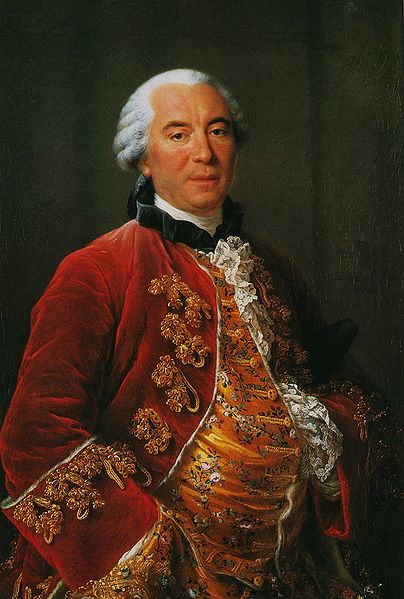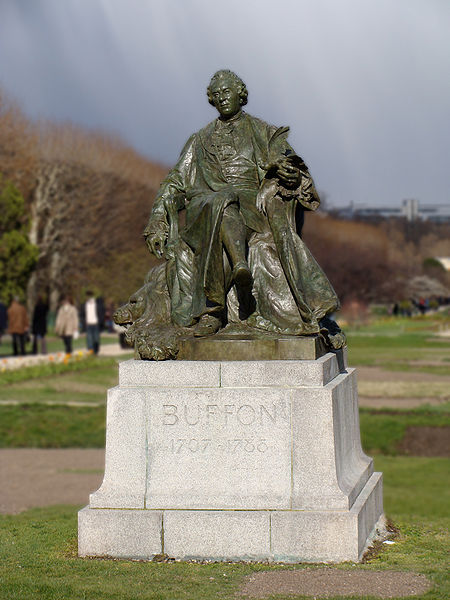<Back to Index>
- Naturalist Georges Louis Leclerc, Comte de Buffon, 1707
- Sculptor Johan Tobias Sergel, 1740
- Queen of England and Ireland Elizabeth I, 1533


Georges-Louis Leclerc, Comte de Buffon (7 September 1707 – 16 April 1788) was a French naturalist, mathematician, cosmologist, and encyclopedic author. His works influenced the next two generations of naturalists, including Jean-Baptiste Lamarck and Georges Cuvier. Buffon published thirty-five quarto volumes of his Histoire naturelle during his lifetime; one additional volume based on his notes was published in 1789 after his death. The following has been said of him: "Buffon was the father of all thought in natural history in the second half of the 18th century." Buffon held the position of intendant (director) at the Jardin du Roi, now called the Jardin des Plantes; it is the French equivalent of Kew Gardens.
He was born at Montbard, Côte-d'Or. His father, Benjamin Leclerc, was a magistrate in the Parlement of Dijon. Georges-Louis attended the Jesuit College of Godrans in Dijon from the age of ten onwards, and then the University of Dijon and the University of Angers. He began studying law, but soon began to concentrate on his twin
interests of mathematics and science. He was later forced to leave the
university after becoming involved in a duel, and set off on a grand
tour of Europe, returning when his father's remarriage threatened his
inheritance. In 1732 he moved to Paris, where he made the acquaintance of Voltaire and other intellectuals. He first made his mark in the field of mathematics and, in his Sur le jeu de franc-carreau, introduced differential and integral calculus into probability theory; the problem of Buffon's needle in probability theory is named after him. In 1734 he was admitted to the French Academy of Sciences. During this period he corresponded with the Swiss mathematician Gabriel Cramer. His
protector Maurepas had asked the Academy of Sciences to do research on
wood for the construction of ships in 1733. Soon afterward, Buffon
began a long-term study, performing some of the most comprehensive
tests to date on the mechanical properties of wood.
Included were a series of tests to compare the properties of small
specimens with those of large members. After carefully testing more
than a thousand small specimens without knots or other defects, Buffon
concluded that it was not possible to extrapolate to the properties of
full-size timbers, and he began a series of tests on full-size
structural members. In 1739 he was appointed head of the Parisian Jardin du Roi (later the Jardin des Plantes) with the help of Maurepas;
he held this position to the end of his life. Buffon was instrumental
in transforming the Jardin du Roi into a major research center and
museum; he also enlarged it, arranging the purchase of adjoining plots
of land and acquiring new botanical and zoological specimens from all
over the world. Thanks to his talent as a writer, he was invited to join Paris's second great academy, the Académie Française in 1753. In his Discours sur le style ("Discourse
on Style"), pronounced before the Académie Française, he
said, "Writing well consists of thinking, feeling and expressing well,
of clarity of mind, soul and taste .... The style is the man himself" ("Le style c'est l'homme même"). Unfortunately for him, Buffon's reputation as a literary stylist also gave ammunition to his detractors: The mathematician Jean le Rond D'Alembert, for example, called him "the great phrase-monger." He was made Comte de Buffon in 1773. He died in Paris in 1788. Buffon is best remembered for his Histoire naturelle, générale et particulière (1749–1788:
in 36 volumes; an additional volume based on his notes appeared in
1789). Originally intended to cover all three "kingdoms" of nature, the Histoire naturelle ended
up being limited to the animal and mineral kingdoms, but Buffon's view
of natural history as a broad and necessarily theoretical enterprise
ensured that the Histoire naturelle was anything but narrow. "Written in a brilliant style, this work was read ... by every educated person in Europe." Those who assisted him in the production of this great work included Louis-Jean-Marie Daubenton, Philibert Guéneau de Montbeillard, and Gabriel-Léopold Bexon, along with numerous artists. Buffon's Histoire naturelle was translated into many different languages, making him one of the most widely read authors of the day, a rival to Montesquieu, Rousseau, and Voltaire. He questioned the usefulness of mathematics, criticized Carl Linnaeus's
taxonomical approach to natural history, outlined a history of the
earth with little relation to the Biblical account, and proposed a
theory of reproduction that ran counter to the prevailing theory of
pre-existence. The early volumes were condemned by the Faculty of
Theology at the Sorbonne. Buffon published a retraction, but he
continued publishing the offending volumes without any change. In
the course of his examination of the animal world, Buffon noted that
despite similar environments, different regions have distinct plants
and animals, a concept later known as Buffon's Law, widely considered
the first principle of biogeography.
He made the suggestion that species may have both "improved" and
"degenerated" after dispersing from a center of creation. In volume 14,
in particular, he argued that all the world's quadrupeds had developed
from an original set of just thirty-eight quadrupeds. On
this basis, he is sometimes considered a "transformist" and a precursor
of Darwin. He also asserted that climate change may have facilitated
the worldwide spread of species from their centers of origin. Still,
interpreting his ideas on the subject is not simple, for he returned to
topics many times in the course of his work. Buffon
considered the similarities between humans and apes, but ultimately
rejected the possibility of a common ancestry. He debated with James Burnett, Lord Monboddo, on the relationship of the primates to man, Monboddo insisting, against Buffon, on a close relationship. At one point, Buffon propounded a theory that nature in the New World was inferior to that of Eurasia.
He argued that the Americas were lacking in large and powerful
creatures, and that even the people were less virile than their
European counterparts. He ascribed this inferiority to the marsh odors
and dense forests of the American continent. These remarks so incensed Thomas Jefferson that he dispatched twenty soldiers to the New Hampshire woods to find a bull moose for Buffon as proof of the "stature and majesty of American quadrapeds." Buffon later admitted his error. In Les époques de la nature (1778) Buffon discussed the origins of the solar system, speculating that the planets had been created by a comet's collision with the sun. He also suggested that the earth originated much earlier than 4004 BC, the date famously determined by Archbishop James Ussher. Basing his figures on the cooling rate of iron,
he calculated that the age of the earth was 75,000 years. Once again,
his ideas were condemned by the Sorbonne, and once again he issued a
retraction to avoid further problems. Charles Darwin wrote in his preliminary historical sketch added to the third edition of On the Origin of Species:
"Passing over... Buffon, with whose writings I am not familiar." Then,
from the fourth edition onwards, he amended this to say that "the first
author who in modern times has treated it [evolution] in a scientific
spirit was Buffon. But as his opinions fluctuated greatly at different
periods, and as he does not enter on the causes or means of the
transformation of species, I need not here enter on details." The paradox of Buffon is that, according to Ernst Mayr: He
was not an evolutionist, yet he was the father of evolutionism. He was
the first person to discuss a large number of evolutionary problems,
problems that before Buffon had not been raised by anybody.... he
brought them to the attention of the scientific world. Except for Aristotle and Darwin, no other student of organisms [whole animals and plants] has had as far-reaching an influence. He brought the idea of evolution into the realm of science. He developed a concept of the "unity of type," a precursor of comparative anatomy.
More than anyone else, he was responsible for the acceptance of a
long-time scale for the history of the earth. He was the founder of biogeography.
And yet, he hindered evolution by his frequent endorsement of the
immutability of species. He provided a criterion of species, fertility
among members of a species, that was thought impregnable.